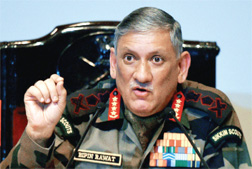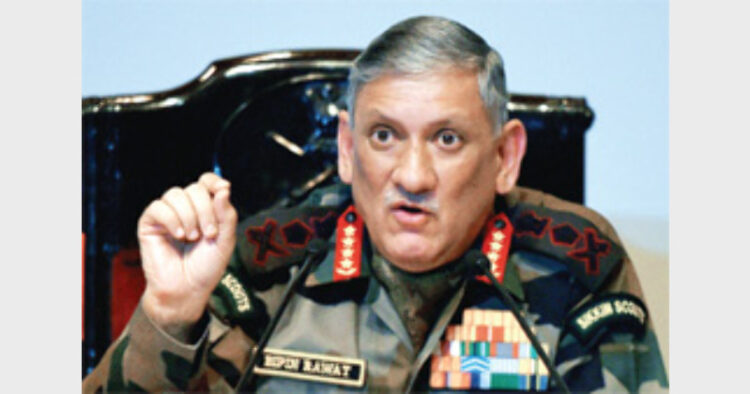 The Army Chief’s loud thinking was an apt observation by a professional who knows how these encounters pan out and how essential it is for troops to remain focused
The Army Chief’s loud thinking was an apt observation by a professional who knows how these encounters pan out and how essential it is for troops to remain focused
Lt Gen (Retd) Syed Ata Hasnain
Indian Army Chief, General Bipin Rawat, in the context of six fatalities suffered by the Army in three encounters in the Kashmir Valley recently alluded to the growing phenomenon of flash mobs descending on the encounter sites where the Security Forces (Army, CRPF and JK Police) were engaged in operations with holed- up terrorists.
These mobs concentrate with the purpose of diverting attention, preventing effectiveness of the operation and affording an escape for the terrorists. This is wholly a new
phenomenon adopted since 2015 but became far more widespread towards the end of 2016. The Army Chief observed that the recent Army casualties were a direct outcome of such methods adopted by a section of the public in the Valley and that in future the Army would be tough on those indulging in such acts and other actions which are largely anti-national.
The Army Chief’s words were hailed by the security agencies where some amount of consternation about lack of clarity in such operations has been making rounds. It is never good to keep the rank and file in doubt about the concept. Even more than that, an Army Chief publicly backing his rank and file is always great for the morale of the force.
The Army Chief’s loud thinking was an apt observation by a professional who knows how these encounters pan out and how essential it is for troops to remain focused throughout to ensure mission accomplishment without casualties. Being extensively experienced in these operations he was obviously giving his perspective at a time when there has been an increase in casualties. The
message is for all; that the army would not accept intimidation which leads to higher casualties. He was neither
framing new rules of engagement nor giving a threat. His message was crystal clear – that the situation arising out of employment of intimidation by
sponsored mobs at encounter sites would no longer be accepted as benignly as had been done thus far and that the security forces would be forced to take action against such mobs.
For long everything that happened in the J&K would remain within the realm of perception. Personalities, interest groups and political parties know the ground realities well enough but fail to comprehend the national interest, many times deliberately viewing events,
utterances and outcomes from the narrow confines of perception. However,
misinterpretation and misperception broke all records when the Army Chief’s statement was taken by some as a
message to his officers and troops to hereafter target the Kashmiri population.
Prominent personalities within the valley projected the words of the Army Chief as typical of India’s stance against the people and the only way that the Army functioned. For them, alienation being an outcome of such attitude.
However, for the same perception
to be parroted in New Delhi by media
personalities, analysts, former
bureaucrats and opposition politicians is indeed surprising. A former Minister called it an ‘intemperate statement’;
others termed it a turnaround from the established practice of engagement; some even disliked the Chief expressing his concern publically and felt that such things must be spoken only by the civilian leadership or those authorized to speak. It is actually shocking that there are people who consider an Army Chief speaking about military operations, casualties and how he intends to overcome the challenge to be outside his purview.
I had the most difficult time warding off these perceptions on the visual media. The Army Chief has extensively handled operations in Kashmir, perception and media; the analysts and the commentators have academic knowledge of the situation. They see everything through the prism of conventional war and counter insurgency. Giving an Army Chief his space in a domain he understands very well is the least they could do.
Two observations are necessary at this stage, for the sake of explaining to India’s poorly informed segment which imagines that its Army will go with guns blazing against unarmed people. Firstly, it is a
truism that in recent times the propensity to find fault with the Army’s handling of situations in hybrid conflict is increasingly coming under ill-informed
critique, who assume
expertise in affairs of which they have little knowledge and even less experience. Secondly, the ability of the Army to protect its flanks and its rear, in terms of such
critique, is woefully poor. It is extremely simple to target the military leadership and the soldiers and accuse them of mismanagement and incompetence because there exists no official machinery to project their perception. Not that it matters; soldiers are supposed to be thick skinned. However, when the same becomes almost a campaign there appears more than meets the eye.
There is no doubt that India’s
democracy is strong and vibrant but the sentiments of its soldiers also need to be factored into the narrative. What is
surprising is the perception of educated people taking the Army Chief”s words as a threat. When a professional Army does not mince words about interference in its operations you find people thinking that it is threatening an entire population. Who better than the Indian Army understands the value of the people being in its
support. In Somalia, the United Nations was surprised to see the amount of focus the Indian Army contingent gave to winning over the local people, something which is part of the concept of
operations it follows where ever deployed in operations involving people.
In Sep 2016 two full brigades of the Army were about to deploy in South Kashmir to afford better
domination of the space then occupied by the mobs. I, out of sheer concern proffered advice; the Army needed none of it. The time tested teaching of the Army clearly outlines for its ranks that when involved in operations in an irregular warfare environment the driving element towards success is the moral standing that the force is able to establish. It meant that at the cost of everything troops needed to be oriented to the type of operations they were about to undertake and ensure the full recognition and understanding of the necessity of winning the hearts and minds of the people. This ,of course, will always be balanced with calibrated military pragmatism to ensure that there is no absolutism which will direct the soldier’s energy. So when the Army Chief goes public on a potential change of tack in operations it does not mean loss of sense of balance. The operative side of the message is equally important. The security forces had a difficult times
finding ways of combatting the dual menace of street turbulence synced with terrorist actions. They need to develop doctrines which will ensure the isolation of the area of an encounter without handing the initiative either to the rabble rousers in separatist ranks or the mobs themselves. The Chief’s message was just that.
Why should issues concerning the armed forces inevitably end up being controversial on every count. The armed forces need professional information
handling capability and empowerment.
(The writer is a former GOC of the Srinagar-based 15 Corps. Now a senior analyst at Vivekanand International Foundation and Institute of Peace & Conflict Studies)













Comments